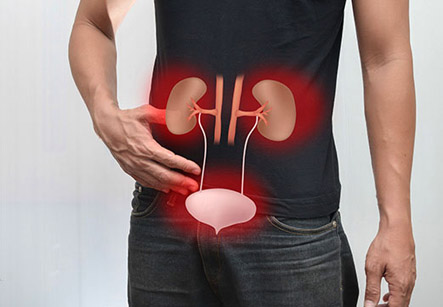Cystoscopy
Introduction
Cystoscopy is a urological procedure applied to study the urinary bladder and urethra from inside with a help of hollow tube-like equipment, called as cystoscope. It is also termed as cystourethroscopy. The cystoscope is inserted into your urethra and slowly advanced into your bladder. It is equipped with a lens which scans the inner lining of the urinary bladder and urethra.
The type of cystoscopy depends on the reason for your procedure. This procedure may be done by using:
• local anesthesia which makes the urethra numb, in order to diminish the pain, in case of outpatient clinics.
• regional or general anesthesia in hospital setting.
Cystoscopy is most often done as an outpatient procedure. Before the procedure you will empty your bladder

Indications
Conditions affecting the urethra and urinary bladder can be diagnosed, monitored or treated by using cystoscopy. Cystoscopy can be recommended by a doctor in following cases:
• For studying the causes of bladder signs and symptoms, like- blood in the urine, frequent urinary tract infections, incontinence, overactive bladder and painful urination.
• For diagnosing an enlarged prostate, medically termed as benign prostatic hyperplasia. Cystoscopy helps reveal a narrowing of the urethra where it passes through the prostate gland, indicating an enlarged prostate.
• For diagnosing the urinary bladder and urinary tract diseases like- bladder cancer, bladder stones and bladder inflammation (cystitis).
• For treatment of bladder diseases. Special tools can be inserted through the cystoscope to treat a bladder disease. Very small bladder tumours may be removed during cystoscopy.
Sometimes, urologists may recommend a procedure called ureteroscopy to study urinary tract beyond the bladder while cystoscopy is being done simultaneously. Procedure of ureteroscopy uses a smaller scope to examine the ureters – the tubes that carry urine from your kidneys to your bladder.
Cystoscopy may show following complications:
• Cystoscopy can rarely set up infection into the urinary tract. Cystoscopy may also irritate an existing urinary tract infection, worsening it. In select cases, your doctor may prescribe antibiotics to take before and after your cystoscopy to prevent infection.
• Bleeding. Cystoscopy usually causes some blood in your urine, but in rare cases, bleeding may be more serious.
• Pain. Cystoscopy may cause abdominal pain and a burning sensation when urinating. In most cases, these symptoms are mild and gradually decrease after the procedure.
Signs and symptoms of a complication
Call your doctor or go to the nearest emergency room if you experience:
• Bright red blood in your urine
• A fever higher than 100 F (38 C)
• Pain or burning during urination that lasts more than two days
Procedure:
During the cystoscopy
To prepare for your cystoscopy procedure, you’ll be asked to empty your bladder. You’ll lie down on a table on your back. In some cases, you may be positioned with your feet in stirrups so that your knees are bent and elevated.
In certain cases, you may receive a sedative or an anesthetic medication through a vein in your arm before the cystoscopy procedure. If you receive a sedative, you’ll feel sleepy and relaxed during the cystoscopy, but you’ll still be aware. If you receive a general anesthetic during the cystoscopy, you won’t be aware during the procedure.
A numbing jelly will be applied to your urethra so that you feel less pain when the cystoscope is inserted. After waiting a few minutes for the numbing to occur, your doctor feeds the cystoscope into your urethra.
When done in a hospital setting with sedation or general anesthesia, cystoscopy can take 10 to 30 minutes.
Several sizes of cystoscopes are available, and your doctor will choose the smallest scope possible for your procedure. Smaller scopes are often used for investigating causes of signs and symptoms. Larger scopes may be necessary to take tissue samples or pass surgical tools into the bladder.
As the cystoscope passes through your urethra and toward your bladder, your doctor will look through a lens on the end of the cystoscope. The lens works like a telescope to magnify the inner surfaces of your urethra and your bladder. In some cases, your doctor may place a special video camera over the lens that projects the images onto a video screen.
Once the cystoscope reaches your bladder, your doctor will flood the bladder with a sterile solution. The solution inflates the bladder and allows your doctor to get a better look at the inside of the entire structure. As your bladder fills, you may feel the need to urinate. This can be an uncomfortable feeling. As soon as your cystoscopy is complete, you’ll be allowed to empty your bladder.
Depending on your situation, your doctor may take tissue samples or perform various procedures during the cystoscopy. Once these are complete, the cystoscope is withdrawn through your urethra. A simple outpatient cystoscopy may take less than five minutes. When done in a hospital setting with sedation or general anesthesia, cystoscopy can take 10 to 30 minutes.